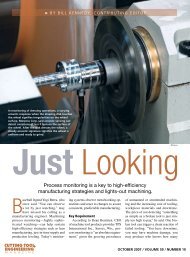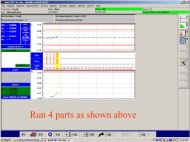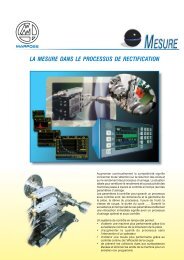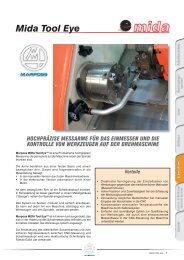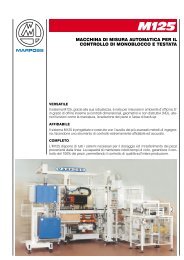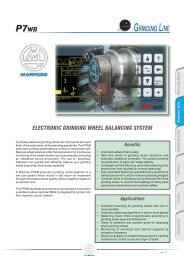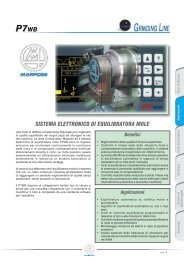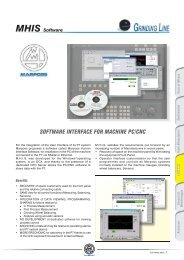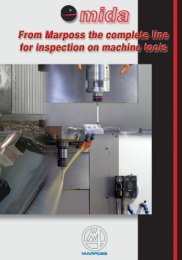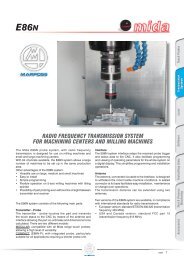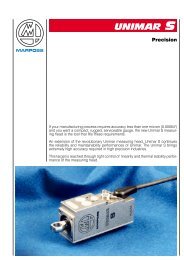Auto Manufacturing Focuses on Vision - Marposs
Auto Manufacturing Focuses on Vision - Marposs
Auto Manufacturing Focuses on Vision - Marposs
Create successful ePaper yourself
Turn your PDF publications into a flip-book with our unique Google optimized e-Paper software.
<str<strong>on</strong>g>Auto</str<strong>on</strong>g>motive Metrology<br />
that is as automatic as possible,” explains Alex Lucas, product<br />
manager for Nik<strong>on</strong> Metrology. “We deliver many dual-arm<br />
CMMs al<strong>on</strong>g with our CMM-based laser scanners for those<br />
applicati<strong>on</strong>s. The laser scanner provides advantages in speed,<br />
high accuracy, and ease of programming and use.” A typical<br />
dual-arm CMM include Nik<strong>on</strong>’s LK H brand, such as the LK<br />
H-R with rail lengths from 4 to 10 m or more. While equipped<br />
standard with a PH10MQ touch probe, these horiz<strong>on</strong>tal-arm<br />
CMMs can also be equipped with <strong>on</strong>e of Nik<strong>on</strong>’s laser scan<br />
heads. “The most popular is the XC65Dx-LS,” notes Lucas. “I<br />
estimate it is at least 75% of all scanners we sell into producti<strong>on</strong><br />
inspecti<strong>on</strong> for automotive applicati<strong>on</strong>s.”<br />
The XC65Dx-LS uses a cross pattern of three laser stripes,<br />
acquiring a better 3-D view when scanning parts with more<br />
complex surface shapes and better able to detect holes and<br />
edges. Its measuring uncertainty is 20 µm to 1σ within a 3 ×<br />
65-mm field of view. “The real advantage of that over other<br />
CMM scanning products is the l<strong>on</strong>g standoff distance of<br />
170 mm. That is where LS comes from,” says Lucas. This is<br />
the maximum distance the sensor head can be away from<br />
the surface it is measuring. This provides better maneuverability<br />
and makes it easier to program the CMM. “We can<br />
also deliver this <strong>on</strong>to third-party CMMs; we are not limited to<br />
Nik<strong>on</strong> equipment,” remarks Lucas. Ideal for sheetmetal and<br />
stamped parts, he notes customers are using the XC65Dx-LS<br />
to measure parts ranging from individual comp<strong>on</strong>ents all the<br />
way to entire bodies-in-white.<br />
He notes that few customers want to exploit the increased<br />
speed of scanning for 100% inspecti<strong>on</strong>. Most, if not all,<br />
prefer to remain with a statistical sampling for producti<strong>on</strong><br />
and process c<strong>on</strong>trol. “3-D scanning provides the capability<br />
to measure parts fully. You can compare the measurements<br />
with CAD to produce full color, 3-D renditi<strong>on</strong>s of deviati<strong>on</strong>s.<br />
However, producti<strong>on</strong> people are not that interested in that,”<br />
he says, remaining the domain of research labs or engineers<br />
engaged in troubleshooting of designs or process. “What most<br />
want is to quickly get data they need to track their processes.<br />
So we have many customers who replace a touch trigger<br />
probe with a laser and sample just a few areas with what<br />
might be termed targeted laser scanning and reduce the data<br />
down to specific (x-y-z) points for comparis<strong>on</strong>s,” he explains.<br />
This delivers faster measuring cycles, usually between 50%<br />
and 70% faster. He also believes that large-scale plastic<br />
comp<strong>on</strong>ents, such as instrument panels, are becoming more<br />
interesting for this targeted laser scanning approach, especial-<br />
ly involving soft materials that might be deflected by a touch<br />
or scanning analog probe.<br />
White Light Systems<br />
White light<br />
systems are<br />
another device<br />
that offers widearea<br />
scanning for<br />
n<strong>on</strong>c<strong>on</strong>tact metrology.<br />
Under the<br />
Cognitens brand,<br />
Hexag<strong>on</strong> Metrology<br />
(North Kingstown,<br />
RI) offers white<br />
light (now actually<br />
blue) sensors for<br />
3-D measurements<br />
ideal for automotive<br />
bodywork. Using<br />
fringe patterns,<br />
these n<strong>on</strong>c<strong>on</strong>tact/<br />
visi<strong>on</strong> systems<br />
capture data in<br />
up to 500 × 500<br />
mm tiles, delivering<br />
measurement<br />
accuracy for a<br />
<strong>on</strong>e-meter volume<br />
at about 25 µm to<br />
Fully enclosed cabinets c<strong>on</strong>taining<br />
2 σ, according to<br />
optical measuring devices are<br />
Cliff Bliss, nati<strong>on</strong>al<br />
ideal for placing near or <strong>on</strong> the<br />
manager for Cog-<br />
producti<strong>on</strong> floor.<br />
nitens. There is a<br />
manual opti<strong>on</strong>, the WLS400M, and an automated system, the<br />
WLS400A, that work with off-the-shelf robots. Their market<br />
niche is bigger parts as well, body stampings and bodies-inwhite,<br />
according to Bliss.<br />
Bliss sees a difference in how the systems are used. “Historically,<br />
the manual system has sold better than the automated<br />
system, but I see that changing as time goes <strong>on</strong>,” he says.<br />
Manual systems have proven themselves in assembly proveouts,<br />
tool try-outs, and the general development process in<br />
manufacturing. Tooling and dies for stampings are measured<br />
meticulously during initial first shots, where engineers tune in<br />
Photo courtesy Hommel-Etamic America



